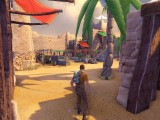Major video game launches are a huge deal these days, and sprawling, feature-rich open-world titles like Obsidian Entertainment’s Fallout: New Vegas come very close to being MMO-like in their courting with danger. As soon as the early reviews begun pouring in, New Vegas indeed turned out to be just as bug-riddled as Fallout 2 originally was back in 1998:
At least the player above got in-game, though – while personally installing Fallout 3, I was met with a faulty DVD, an “Error: -5006 : 0x8000ffff” notice and finally the magnificent extent of Bethesda’s Windows 7 support. A veritable brick wall, in other words… in any case, New Vegas senior designer Chris Avellone, who also worked as designer on the aforementioned Fallout 2 (a connection that we detailed in an earlier post, From New Reno to New Vegas), quite unsurprisingly explains away the bugs with the length and scope of the game:
I think when you create a game as large as Fallout 3 or New Vegas you are going to run into issues that even a testing team of 300 won’t spot, so we’re just trying to address those as quickly as possible and so is Bethesda. … It’s kind of like the bugs of the real world – the sheer expanse of what you’re dealing with causes problems. 1)http://www.computerandvideogames.com/article.php?id=271206
In other words, having never completed Fallout 3, it becomes much easier for me simply to stand back and enjoy the show of fireworks until this latter-day Frankenstein’s monster gets stitched together and squeezed into yet another “Game of the Year” box. I don’t mean at all to imply that I find enjoyment in Obsidian and Bethesda’s misfortunes; instead, what’s exciting to me are the dynamics and mechanics of a major botched launch… after all, instances such as these are rare glimpses into closed-door game design and corporate decision-making at its most tangible, glimpses that only really become available if something goes truly awry. (more…)
References
 Bear with me as this post is largely hearsay given players in the EU are currently locked out of the game at this juncture, but the general assumption to be made here is that the combat more closely resembles that of other Source titles like Dark Messiah of Might & Magic and Zeno Clash, in turn bridging the gap between an MMORPG and an online dungeon crawler. There are other ways, too, in which the utilization of the Source engine affects the game’s overall design and gameplay. The Source base becomes more evident in the trailer below, illustrating a wider-than-usual array of smooth close combat:
Bear with me as this post is largely hearsay given players in the EU are currently locked out of the game at this juncture, but the general assumption to be made here is that the combat more closely resembles that of other Source titles like Dark Messiah of Might & Magic and Zeno Clash, in turn bridging the gap between an MMORPG and an online dungeon crawler. There are other ways, too, in which the utilization of the Source engine affects the game’s overall design and gameplay. The Source base becomes more evident in the trailer below, illustrating a wider-than-usual array of smooth close combat: In fact, there are already three promising Unreal Tournament 3 mods that have not only made the jump over to the UDK but also gone commercial, and curiously, UDK is not the only factor that binds all these three projects together. Each these teams also took part in the
In fact, there are already three promising Unreal Tournament 3 mods that have not only made the jump over to the UDK but also gone commercial, and curiously, UDK is not the only factor that binds all these three projects together. Each these teams also took part in the 

